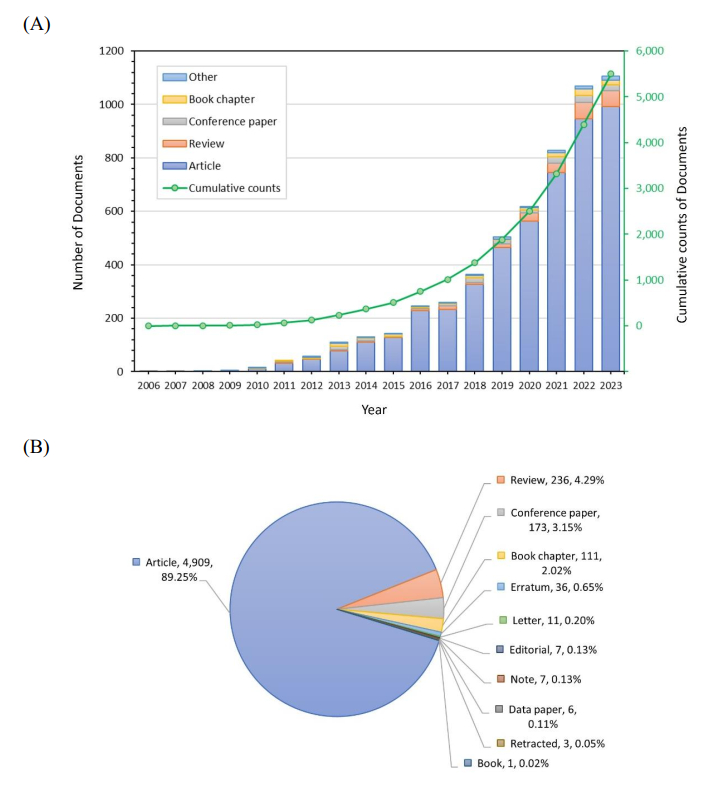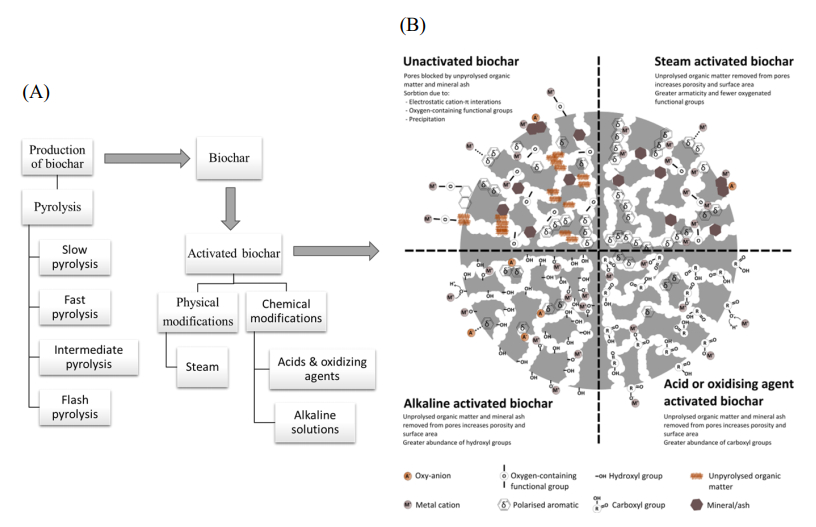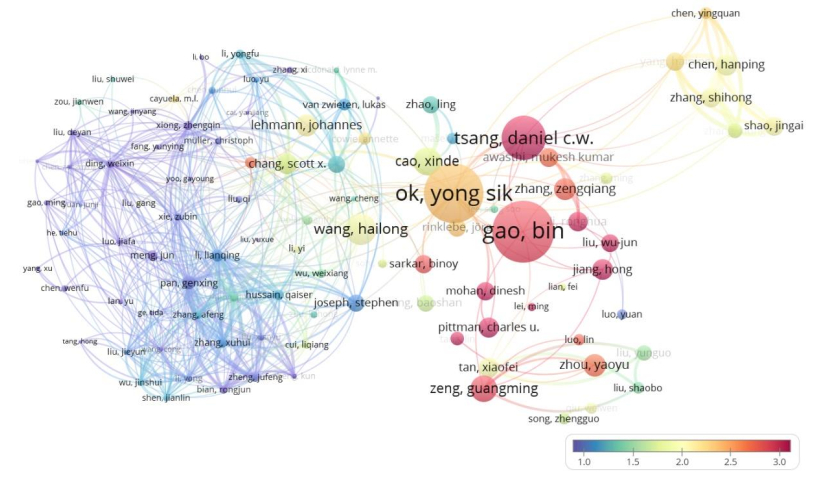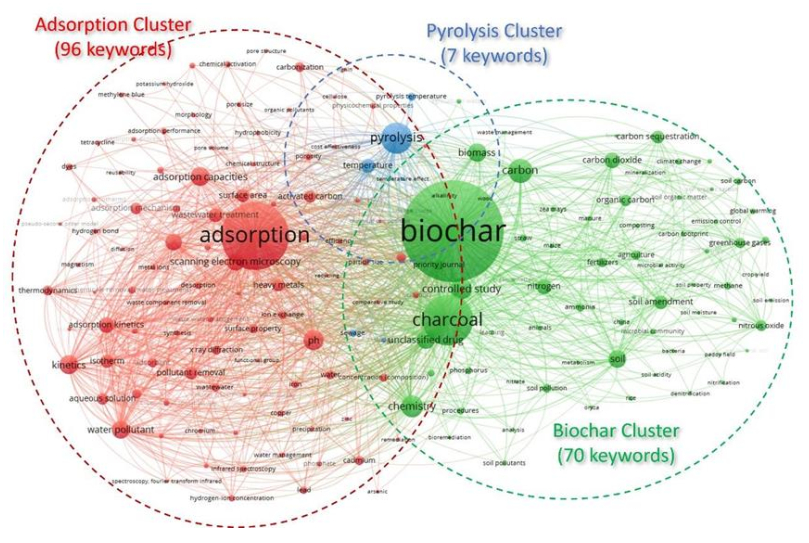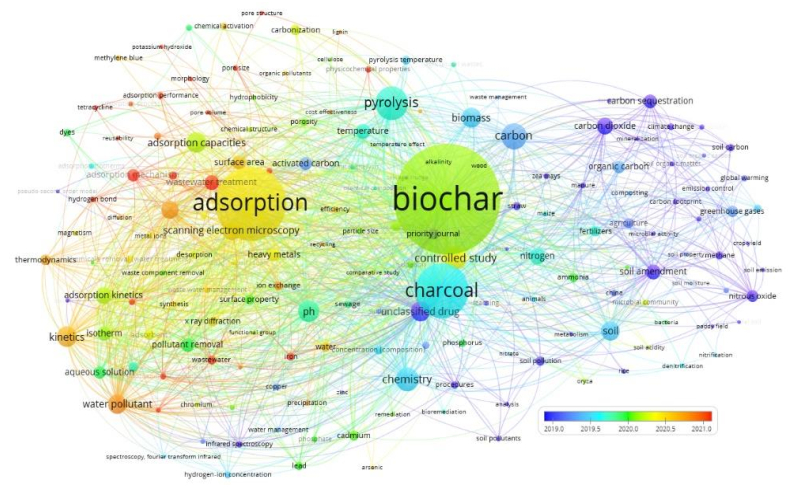1.
Introduction
Given the intensifying climate crisis, the need to find sustainable and efficient methods for carbon capture and storage is now crucial [1,2,3,4]. Anthropogenic carbon dioxide emissions have surged to unprecedented levels, making it essential to discover innovative ways to counter the negative effects of climate change [5,6,7].
In the present scenario, biochar, owing to its high carbon content, is poised to play a crucial role in carbon sequestration or "biochar carbon removal" [8,9,10,11]. It achieves this by securely harboring carbon in a stable form, characterized by a relative resistance to decomposition and microbial breakdown, thereby extending this stability over periods spanning hundreds of years. This stands in stark contrast to other organic materials, such as leaves and wood, which are prone to relatively swift decomposition, subsequently releasing carbon back into the atmosphere in the form of CO2 [12]. Consequently, biochar emerges as a prospective tool for carbon capture and storage or sequestration (CCS) has gained recognition among scientists and policymakers as a viable strategy for addressing climate change and achieving carbon neutrality [4,7,13,14,15].
Previous reports and scholarly publications in this domain confidently underscore that biochar constitutes a pivotal component within the spectrum of mitigation options in agriculture, forestry, and other land uses. Drawing from a comprehensive analysis presented by the Intergovernmental Panel on Climate Change [15], biochar emerges as a significant contributor to carbon sequestration, spanning a projected range of 0.3–6.6 GtCO2-eq by the year 2050. Similarly, in terms of economic potential (valued at < USD 100 per tCO2), projections approximate a range of 0.3–1.8 GtCO2 per year, as supported by estimations. This estimate is derived from a meticulous survey of the literature, quantifying sustainable global negative emission technology (NET) potentials for 2050 within the range of 0.5–2 GtCO2 per year, accompanied by a monetary valuation ranging from USD 30–120 per tCO2 [16].
Furthermore, biochar contributes to the enhancement of soil structure and the facilitation of aggregate formation [17,18]. This augmentation holds the promise of optimizing water retention, promoting nutrient accessibility, and invigorating microbial activity to increasing crop yields [12,19].
Both biochar and CCS play pivotal roles in the domain of decarbonization. Biochar primarily focuses on carbon sequestration within the soil through agricultural practices, while CCS addresses emissions stemming from larger-scale industrial sources [7,20]. Despite their divergent applications and scales, both avenues significantly contribute to the mitigation of climate change by curbing atmospheric levels of carbon dioxide [21,22].
Recently, VOSviewer has been utilized as a bibliometric tool to quantitatively analyze global connections. It visually explores prominent authors, highly cited literature, and research trends, aiming to elucidate the comprehensive knowledge structure and context within the discipline [23,24].
To the best of our knowledge, no study has reported using bibliometric analysis to investigate scholarly output based on data extracted from the Scopus database on biochar and CCS in the last two decades from initial phases to recent years. The bibliometric analysis of biochar in carbon capture and storage (CCS) research provides a comprehensive framework for leveraging scientific publications in the field. The outlined approach encompasses key stages, starting with the identification of trends and influential authors through bibliometric analysis. This process not only informs decision-making by highlighting impactful studies and experts but also sets the stage for a thorough literature review.
The literature review and knowledge synthesis, guided by bibliometric insights, contribute to a comprehensive understanding of the current technology landscape in biochar CCS research, with a specific focus on engineering-related findings and methodologies. The subsequent gap analysis aids in identifying areas where additional research is crucial, emphasizing engineering applications and practical implications in process design.
2.
Materials and methods
2.1. Bibliometric analysis
Bibliometric analysis, as a robust quantitative technique, furnishes valuable insights into the intricate network of scholarly literature and scientific publications [25]. By meticulously scrutinizing bibliographic data, including citations, authors, and journals, researchers can identify patterns, trends, and influential contributions within their field of study [26]. This analytical approach enables decision-makers to make well-informed choices concerning research funding, pinpoint key collaborators, and assess the impact of scientific endeavors. Through providing an objective assessment of research productivity and influence, bibliometric analysis stands as an indispensable tool in the pursuit of knowledge advancement and evidence-based decision-making [27].
In this study, two primary sources collaborated: the first source derives data from the Scopus database, and the second source involves VOSviewer, utilized for bibliometric mapping programs.
VOSviewer stands as a mapping visualization software developed by experts from Leiden University in the Netherlands [27]. Through VOSviewer, one can generate graphs for authors, citations, keywords, and other data co-occurrences [28]. This tool brings unique advantages in the realms of mapping and clustering [29]. Employing factors like distance and density, VOSviewer deconstructs the clustering relationship between nodes [30,31]. In recent years, VOSviewer of bibliometrics was used to quantitatively analyze the relationship between biochar and soil carbon sequestration and climate change mitigation [32]. It also was used for data analysis and visualization on the co-application of biochar for crop yield production and soil remediation [33], research trends of aging biochar for agro‑environmental applications [34], multifaceted applications of biochar in environmental management [35], and research progress and trends of biochar in the field of wastewater treatment [36].
The limitations of bibliometrics include database inconsistencies, potential inaccuracies, missing citations, and keywords in the analysis program. Furthermore, the information may lack a comprehensive understanding of individual studies. Despite these disadvantages, bibliometric analysis remains a valuable tool for understanding research trends, identifying influential works, and assessing the impact of research outputs.
2.1. Work processing and data collection
This study utilized technological innovation, specifically bibliometric analysis, to assess the influence of researchers, institutions, or journals in the field of biochar on CCS. It aimed to identify emerging trends and hot topics within this area. Additionally, the analysis was employed to evaluate the impact of research articles, measure the effectiveness of research collaborations and networks, and facilitate decision-making for academic institutions and researchers.
The bibliographic databases employed for bibliometric analysis include Web of Science (WoS), Scopus, and PubMed [32,33,34,35,36]. In this research, we opted for Scopus for bibliometric analysis due to its facilitation of data download for bibliometric applications, alignment with comprehensive scientific coverage, and provision of a robust tool for measuring scientific impact [37,38]. The detailed procedure of bibliometric analysis is depicted in Figure 1.
The search was conducted using the keywords from the title keywords. The retrieval term is TS = Title (biochar AND (carbon* OR captur* OR storag* OR sequestrat* OR emis* OR mitigat* OR adsor* OR "climate change")). TS represents the "theme subject" search in the Scopus database search. Using keywords, the TS retrieval technique based on Boolean logic can quickly and simply find a large amount of literature data related to the topic [39]. The asterisk in "carbon*" is used to retrieve all potential derivatives of the words, while the quotation marks are used to obtain accurate and exact formulations. As a consequence, for instance, the term "carbon" functions as the root phrase for various related words, such as "carbonic", "carbonize", "carbonization" and "carbon-neutral". After the screening, comparison, and evaluation, a total of 5,500 bibliography entries were ultimately gathered spanning the period from 2006 to 2023. Each entry encompasses information such as authors, institutions, abstracts, keywords, publication years, journals, and references. Due to the presence of duplicate papers, fictitious items, or synonymous keywords in the original dataset, processing the literature data becomes a crucial prerequisite for obtaining accurate analysis results. Improper handling of this data may result in overestimated word frequencies or incorrect computations, thereby yielding unreliable or even contradictory outcomes. The extracted data will undergo three main processing steps: removal of duplicate entries, elimination of irrelevant items, and consolidation of synonymous terms.
Subsequently, VOSviewer is employed for data analysis and visualization utilizing two techniques: 1) The size of the circle indicates the number of times it has been cited, and the outline weight corresponds to the total link strength (TLS). In bibliometric analysis, TLS quantifies the overall strength or significance of connections between various elements in a network or system. In the context of bibliometrics, this often pertains to the relationships and connections among scholarly publications, authors, journals, or research topics. TLS can be utilized to assess the impact, influence, or interconnectedness of research entities within a specific field. 2) The color shade of overlay visualization signifies the interpretation of crucial variables, including the progression of research work denoted by the publication year. The average normalized citations (ANC) serves as a metric for gauging the popularity and impact of the mentioned variables. Elevated ANC values denote more frequent citations, signifying greater importance and respect within the field.
3.
Results and discussion
3.1. General evolution trend analysis
Analyzing data from the Scopus database covering the period between 2006 and 2023, presented in Figure 2, a total of 5500 articles were related to biochar in CCS. Figure 2A shows the total documents, including 4909 original articles, 236 reviews, 173 conference papers, 111 book chapters and 71 others (erratum, letter, editorial, note, data paper, retracted, and book). Among all of the publications, original articles occupied 89%, followed by reviews (4%), conference papers (3%) and book chapters (2%), as presented in Figure 2B. The total count of publications throughout the entire period grows exponentially as time progresses.
Research papers on "biochar in carbon capture and storage" show a significant exponential increase from 2006 to 2023. In the initial period (2006–2015), the number of documents published gradually increased, with a total of 142 documents published in a decade. However, the growth rate was relatively slow, and less than 15 documents were published in the Scopus database every year on average. Although there are few studies of this period, there is no shortage of high-quality research in this field, which paved the pathway to progress for subsequent research to various fields. Moreover, nine of the top 10 of total citations also appeared during this period: for instance, examination of the molecular-level attributes of chars derived from biomass, with a specific emphasis on aromatic carbon within char structures. Employing techniques such as Brunner-Emmett-Teller-N2 surface area analysis, X-ray diffraction, synchrotron-based near edge X-ray absorption fine structure, and Fourier transform infrared spectroscopy, the study investigates the influence of charring temperature (ranging from 100 to 700 ℃) on chars derived from wood and grass. The results identified four distinct char categories characterized by unique chemical phases and physical states, implying potential differences in environmental persistence and sorbent functionality [40]. The research for sustainable biochar to mitigate global climate change explore the potential of biochar, a carbon-rich solid produced through biomass pyrolysis, as a method to mitigate climate change by sequestering carbon in soils. The study estimates that biochar could annually reduce carbon dioxide (CO2), methane, and nitrous oxide emissions without compromising food security, habitat, or soil conservation, making biochar a more effective climate change mitigation strategy compared to biomass combustion [41].
Subsequently, during the rapid development period from 2016 to 2023, research on biochar in CCS increased significantly and was consistently published. During this period, a cumulative total of 4993 documents were published, with a growth rate averaging over 600 documents per year. Additionally, over 1000 documents were published in each of the years 2022 and 2023. In this phase, researchers start focusing on utilizing biochar as a carbon sink to decrease greenhouse gas emissions [42]. The unique properties of biochar have led to a growing interest, finding applications in climate change mitigation, agriculture, environmental remediation, and energy production [43]. The scientific community is increasingly exploring the use of biochar derived from biomass wastes as a sustainable precursor for producing activated carbon. Activation methods, including physical and chemical processes, enhance biochar's properties, making it a promising and eco-friendly material for applications like water pollution treatment, CO2 capture, and energy storage [44]. Figure 3 illustrates a concise overview of the processes involved in the production and activation of biochar.
The trend revealed in the next few years suggests that there might be an increase in the attention given to biochar in CCS. It might be correlated with other issues, such as the structure of biochar, the mechanism of absorption by biochar, modified biochar, and pollution treatment. For instance, Techniques such as using KOH, NaOH, and ZnCl2 to activate biochar at functional groups on the surface have been employed to increase the number and diameter of pores [45]. Global efforts are focused on addressing water scarcity, pollution, and related issues, driving innovations in water treatment technologies [46].
3.2. Overlayed visualization of countries and authors with average citations
Due to significant interest and global research efforts, biochar has been extensively studied and cited across various disciplines. The analysis of countries and average citation rates revealed that the top five nations with high publications and citation rates are China (101415 citations), the United States (48168 citations), Australia (16421 citations), South Korea (15126 citations), and India (11414 citations), respectively (Figure 4 and Table 1).
Studies published by Chinese research teams were predominant in the years 2020–2021, while those from the United States occurred during 2018–2019. China published 3160 papers, more than four times those published by the United States (628 papers). However, the TLS of Chinese publications (19167) is 1.2 times higher than that of American publications (8534). Although China reported the highest number of studies, the impact of works by American researchers was higher.
Australia and South Korea produced a similar number of papers, with 265 and 253, respectively. However, TLS and citations for Australian studies (4558 TLS, 16421 citations) are significantly higher than those from South Korea (3748 TLS, 15126 citations). It is noteworthy that the United Kingdom published 179 papers, but these garnered high citations (11032) compared to countries with a similar quantity, such as Canada, which published 179 papers (6779 citations). Additionally, 74 studies from New Zealand obtained a high TLS (2112), while Pakistan published 171 studies with a TLS of 2155. Nigeria and Aruba are countries demonstrating a growing interest in researching this field, leading to the reporting of numerous studies between 2021 and 2022.
Several groups of authors closely collaborate, forming substantial connections with other groups. A crucial collaborative team has emerged, centered around Ok, Yong Sik, Tsang, Daniel C.W. and Gao, Bin, as presented in Figure 5 and Table 2. Notably, three researchers stand out in terms of both citations and total link strength (TLS): Ok, Yong Sik (7373 citations, 1589 TLS), Gao, Bin (6246 citations, 710 TLS), and Lehmann, Johannes (5155 citations, 444 TLS). Despite authoring only nine publications, Jiang, Hong's studies have garnered significant impact with 3144 citations and 650 TLS.
The network analysis of collaborative researcher groups with impactful and highly cited works shows strong connections, with Ok, Yong Sik, and Gao, Bin, at the core, as illustrated in the orange and red-toned cluster. However, the connectivity within this cluster appears weaker compared to the green and blue-toned cluster, where authors demonstrate substantial interconnectivity. Yet, their contributions exhibit a lesser impact when contrasted with those in the initial group. The collaborative team led by Zhang, Shihong, positioned at the edge of the overall network map, exhibits a lower level of connectivity compared to those situated closer to the map's center.
Analyzing both countries and authors (Figures 4 and 5) reveals a global establishment of scientific communication, enhancing information exchange in the realms of biochar and CCS. Forming collaborative research teams with fellow active researchers in the same or related fields proves advantageous. Authors sharing commonalities in nationality tend to collaborate more readily. Therefore, emphasizing collaborations that transcend backgrounds, institutions, and nationalities, along with recognizing the importance of interdisciplinary cooperation, is crucial. Such initiatives contribute to mutual learning among diverse teams, fostering the swift advancement and varied development of biochar in CCS.
3.3. Co-occurrence analysis of the keywords
By analyzing the co-occurrence of keywords in research papers, we can identify the current areas of focus and potential future paths in the field of biochar in CCS. The analysis classified the linking keywords into three clusters, and the relationship between these different keywords is illustrated in Figure 6, where the size of the keyword hotspots depends on their occurrence. The top 25 keywords with high occurrence are shown in Table 3. The biggest cluster of keywords is red, followed by green and blue colors, respectively. At the same time, the accumulation of red, green, and blue clusters is correlated with each other.
The red cluster (adsorption cluster) consists of 96 keywords, with "biochar" being the central element, occurring 4280 times with a total link strength of 39558. It is closely connected with "adsorption" (occurrence 2707, TLS 2707), making it the most frequently used keyword. Other high-frequency keywords in the red cluster include "pH" (occurrence 691, TLS 12386), "adsorption capacities" (occurrence 649, TLS 8006), "kinetic" (occurrence 635, TLS 10256), and "water pollutant" (occurrence 602, TLS 11129).
Additionally, notable high-frequency keywords include "Fourier transform infrared spectroscopy", "water", "carbonization", "hydrogen bond", "surface property", "heavy metals", "scanning electron microscopy", "desorption", "water component removal", "functional group" and "adsorption kinetic".
There is interesting research related to these keywords. For instance, numerous studies have been undertaken to enhance the physical and chemical characteristics of raw biochar through various processes. These modifications aim to improve the adsorption capacity, providing valuable insights into enhancing its overall performance [47].
Biochar has been extensively studied for its potential in CO2 adsorption, benefiting from its porous structure and the presence of basic functional groups [48,49]. The physical adsorption of CO2 onto biochar primarily relies on its pore structure and surface area. Meanwhile, the presence of surface functional groups depends on chemisorption [49,50].
Furthermore, the adsorption of Cu(II), Cr(VI), Cd(II), and Pb(II) on biochar in water pollutants has been investigated. The results indicated a rapid increase in adsorption within the first 20 minutes, reaching equilibrium. Higher adsorbent doses and charring temperatures improved metal removal, achieving up to 99.86% efficiency at pH = 4 [51].
The green cluster (biochar cluster) consists of 70 keywords, "Biochar" associated with "charcoal" (occurrence 1948, TLS 29353), "carbon" (occurrence 836, TLS 10507), "controlled study" (occurrence 735, TLS 13128) and "chemistry" (occurrence 744, TLS 12489). Additionally, high-frequency keywords include "soil", "soil amendment", "unclassified drug", "carbon dioxide", "nitrogen", "carbon sequestration", "biomass" and "greenhouse gas".
In related published papers, such as biomass, pyrolysis produces biochar, essentially a form of charcoal. However, in several studies, the term "charcoal" is used interchangeably with "biochar" [52]. It is commonly applied to agricultural land and gaining global popularity, acknowledged as a promising method for capturing and retaining atmospheric carbon. Its appeal is further enhanced due to its potential to improve soil quality and fertility [53]. The adsorption of a mixture of 15 different pesticides from water pollutants using biochar and charcoal (produced without pyrolysis) was studied. The findings revealed that biochar exhibited superior pesticide adsorption compared to charcoal. Furthermore, the impact of chemical treatment with phosphoric acid on biochar was more significant than on charcoal [54].
The smallest cluster, represented by blue color, consists of 7 significant keywords, termed the pyrolysis cluster. The most frequently occurring keyword in this cluster is "pyrolysis" (occurrence 1120, TLS 13982), followed by "temperature" (occurrence 446, TLS 6971). High-frequency keywords include "pyrolysis temperature", "temperature effect", "sewage", "sludge" and "sewage sludge".
Fascinating studies are connected to these keywords. For instance, biochar, recognized as pyrogenic black carbon because it is created through pyrolysis, is simply a carbon-rich substance with appealing features, including high permeability, favorable porosity, and an extensive surface area [55,56,57]. Biochar properties, influenced by pyrolysis temperature and feedstock, vary widely, affecting surface area, pH, pore volume, and other factors [58,59,60]. Differences in biomass composition lead to varied physicochemical properties, influencing biochar's effectiveness in improving soil quality [61]. The destruction of chemical structures, such as breaking down aliphatic alkyls and ester groups, as well as exposing the aromatic lignin core under higher pyrolysis temperatures, may result in an increased surface area [62]. Heating biomass to 350–650 ℃ breaks and rearranges chemical bonds, forming new functional groups such as carboxyl, lactone, phenol, and pyrrole [63].
3.4. Keyword publication analysis during the period
The examination distinctly illustrates the progression of key terms across various time intervals, beginning with the analysis of terms in the blue category and advancing towards terms in the red category, as depicted in Figure 7. In the initial phase, comprehensive investigations were conducted on the correlation between biochar and carbon dioxide, carbon sequestration, greenhouse gases, climate change, and nitrous oxide, as shown in the blue hotspot. Furthermore, during this timeframe, significant emphasis was placed on research exploring the associations between biochar, soil amendment, and soil pollution.
Biochar is gaining increased recognition due to its unique physicochemical attributes and diverse applications spanning various sectors, including climate change mitigation, agriculture, environmental restoration, and energy generation [64]. Biomass, commonly employed in biochar production, comprises agricultural residues such as straw, wood scraps, industrial organic waste, and sludge [65,66]. With a historical role as a soil modifier, biochar consistently improves soil carbon sequestration, reduces ammonia and carbon dioxide emissions, alleviates soil compaction, enhances micronutrient availability for plants, and elevates soil pH [67]. Historically, farmers utilized a specialized fertilizer called "haigoe" created by combining human waste with rice husk biochar, applying it to fields before planting [68]. It is crucial to highlight that most of the extensively cited papers in this area concentrate on this stage. These papers laid the groundwork for further studies in the field of biochar for soil carbon sequestration and mitigation.
During the intermediate phase, studies exploring biochar investigated its relationships with charcoal, pyrolysis, biomass, chemistry, nitrogen, and fertilizers, as well as its capacities for adsorption and kinetics. Researchers also examined its surface properties, pH, pollutant removal, and carbonization. The application of biochar amendments resulted in a reduction of carbon dioxide emissions by 18–25% and 19–41% during the initial and subsequent growing seasons, respectively. Additionally, nitrogen dioxide emissions decreased by 71–110% and 39–47% [69].
To optimize the effective utilization of biochar, it is crucial to implement additional modifications that enhance its remediation capabilities. In previous studies, a biochar sample treated with sulfuric acid and activated at 800 ℃ was developed and demonstrated the highest CO2 uptake capacity, adsorbing approximately 2.6 mol/kg at 40 ℃ [70,71].
In pH modification, biochar undergoes treatment after pyrolysis using acidic solutions such as hydrochloric acid, phosphoric acid, and oxalic acid. Acid modification alters the physical and chemical characteristics of biochar, enhancing its ability to adsorb both organic and inorganic pollutants from water and soil [72]. Additionally, alkaline modification involves using a base solution to modify the structure of biochar, either after or before pyrolysis [73]. During the pyrolysis of swine manure, alkaline modification resulted in elevated pH, ash content, yield rate, hydrophilicity, and aromaticity [74].
In the final phase, the focus shifted towards examining biochar's affinity for adsorption, employing techniques such as scanning electron microscopy to study its properties. Researchers investigated its interaction with heavy metals and water pollutants, analyzing factors such as kinetics, thermodynamics, pore structure, and morphology. Moreover, in recent years, several studies have explored the applications of biochar in water-related sectors, specifically concentrating on wastewater and methods for wastewater treatment, as shown in the red hotspot.
Globally, efforts have been directed at addressing increasing water scarcity, reducing pollution of water bodies, and resolving water-related issues, leading to innovations in technologies related to water treatment [75,76]. Biochar provides an alternative method for treating water pollutants, effectively removing various contaminants such as volatile organic compounds, heavy metals, and pesticides [77,78]. A review focused on the preparation methods and physicochemical properties of biochar/biochar-based composites, along with their performance in removing contaminants from wastewater, was conducted [79]. The potential of biochar in wastewater treatment applications involves various reaction mechanisms, such as catalysis, adsorption, redox, or biocidal processes, as reported [80,81]. The improvement of biochar's pore structure and surface has garnered significant attention. Various modification procedures, including amination, surfactant modification, base treatment, acid treatment, and magnetic modification, are employed [82]. The modification of surface properties in the adsorbent through acid or alkali treatments enhances the specific surface area and pore structure of the biochar, influencing the physical adsorption of contaminants [83].
The ANC method assesses the popularity and impact of research publications. In this study, ANC was employed to analyze keywords, and the results are presented in Figure 8. Typically, ANC is utilized to measure a publication's influence and compare it with others in similar or different fields. The analysis revealed a lower influence of works connecting biochar with keywords in the blue hotspots (Figure 9A), which include terms such as soil, soil amendment, fertilizers, greenhouse gas, nitrous oxide, carbon sequestration, organic carbon, charcoal, and more. This lower impact could be attributed to the extensive research and study of these groups of words during the initial period, resulting in fewer opportunities for further exploration and lower impact compared to connections with other words.
Associating biochar with words in green hotspots, such as charcoal, carbon, pyrolysis and biomass, exhibited a higher impact compared to the previous group. Meanwhile, publications linking biochar to orange and red hotspots (including terms like water pollutant, water treatment, pollutant removal, waste component removal, chemical structure, surface area, etc.) demonstrated significantly higher impact than the others (Figure 9B). The knowledge generated by this study can be applied in designing valuable research projects aligned with current trends. For instance, improving the structure of biochar derived from locally problematic biomass could lead to the development of materials, equipment, or systems for capturing carbon dioxide and enhancing environmental quality. The study specifically addresses water pollution issues, currently receiving high attention and having a significant impact. The analyzed data can be utilized for commercialization purposes.
Therefore, an intriguing approach to producing a high-impact study aligning with current trends in this field should involve incorporating keywords from the orange and red hotspots in conjunction with biochar. The top 10 popular publications cited in this field related to Biochar and CCS are illustrated in Table 4.
The five most frequently cited publications in this field include "Dynamic molecular structure of plant biomass-derived black carbon (biochar)" published in Environmental Science and Technology by Keiluweit et al. in 2021 (2,224 citations). The study by Keiluweit and colleagues investigates the molecular structure of biomass-derived chars (biochar), focusing specifically on aromatic carbon. Utilizing various analytical techniques, the research explores how wood and grass chars undergo distinct physical and chemical transformations at varying charring temperatures. The findings reveal four categories of chars distinguished by unique combinations of chemical phases and physical states, significantly impacting environmental persistence and sorption capabilities.
This is followed by "Organic and inorganic contaminants removal from water with biochar, a renewable, low-cost, and sustainable adsorbent - a critical review" by Mohan et al. in 2014 (1,707 citations), "Sustainable biochar to mitigate global climate change" by Woolf et al. in 2010 (1,702 citations), "Development of biochar-based functional materials: Toward a sustainable platform carbon material" by Liu et al. in 2015 (1,094 citations), and "Positive and negative carbon mineralization priming effects among a variety of biochar-amended soils" by Zimmerman et al. in 2016 (1,079 citations).
3.5. Biochar in carbon capture and storage
Biochar is presently employed for climate change mitigation [91] in two distinct contexts, as depicted in Figure 10. First, it is utilized in soil storage, commonly referred to as soil carbon sequestration. Biochar plays a pivotal role in achieving carbon-neutral objectives primarily through carbon sequestration and emission reduction [92,93]. Its carbon sequestration benefits stem from a high content of aromatic carbon [94]. The utilization of biochar storage in soil through agricultural soil management presents substantial potential for carbon sequestration, converting biomass waste into a valuable carbon sink [95].
A country-level life cycle assessment demonstrated that biochar produced from various crop residues could achieve over 920 kg CO2e t-1 sequestration in China, highlighting significant carbon sequestration potential [96]. In a similar vein, a cradle-to-grave life cycle assessment of willow biochar revealed a negative carbon footprint (–1875 kg CO2e t-1), dominated by carbon sequestration (–1704 kg CO2e t-1) [97]. Approximately 63–82% of the initial carbon in biochar was estimated to be stably sequestered in soil over 100 years [98], indicating long-term carbon storage benefits.
Biochar serves as a sink for CO2, CH4 and N2O, contributing to climate change mitigation [99]. Biochar systems have the potential to reduce 3.4–6.3 Pg of CO2 equivalent emissions globally, with around 50% constituting CO2 removal. Furthermore, the use of biochar in lieu of renewable energy could potentially minimize emissions by 95% [100]. Additionally, biochar-based landfill covers have been effective in sorbing CO2 and CH4 emissions from landfills [101].
In the second context, biochar functions as an adsorbent in carbon dioxide separation processes within carbon capture technologies such as direct air capture (DAC) and bioenergy CCS (BECCS) [49]. Published studies highlight biochar's substantial potential for CO2 capture, attributing its efficacy to a large surface area, high micro-porosity, and abundant mineral content [49,102]. Notably, N-doped biochar, produced through urea phosphate impregnation-pyrolysis, exhibits superior CO2 adsorption capacity (1.34 mmol·g−1) due to enhanced microporous structure and various nitrogen-containing functional groups [103].
Research indicates that NH3·H2O activation enhances micropore formation and introduces nitrogen-containing functional groups on biochar surfaces, where these groups play a crucial role in CO2 adsorption [102]. Despite being economically feasible and environmentally friendly, the large-scale use of biochar is hindered by its inherent limitations in porosity and surface chemistry, preventing it from achieving the adsorption capacity of commercial activated carbon [50].
In the realm of climate mitigation, DAC stands out as a promising method to reduce ambient CO2 levels, with biochar serving as a cost-effective and environmentally friendly adsorbent. A study investigating KOH-activated bamboo biochar reveals notable CO2 capture capacity in a fixed-bed reactor, albeit with a reduction in activity under higher humidity conditions [104].
The integration of BECCS with biochar production was examined, specifically by utilizing wood ash, a byproduct from BECCS, as an additive in wood pyrolysis for biochar formation. The addition of wood ash not only catalyzed biochar production, enhancing fixed carbon yield, but also demonstrated economic advantages, with the 20% ash-amended biochar yielding the most substantial cost savings and synergies for BECCS and biochar deployment in carbon sequestration efforts [105].
In the context of United Nations sustainable development goals (SDGs), biochar serves as a carbon-negative technology, sequestering carbon in the soil for an extended period. This contribution aligns with mitigating climate change, as it helps reduce atmospheric carbon dioxide levels. Additionally, CCS directly supports the goal of mitigating climate change by capturing and storing carbon dioxide emissions, preventing their release into the atmosphere [106,107,108].
4.
Conclusions
In conclusion, this study has delved into the vital realm of biochar's role in CCS, offering a comprehensive understanding of its evolution, trends, and global scientific landscape. The urgency to address the escalating climate crisis has propelled researchers to explore sustainable methods, and biochar, with its high carbon content, emerges as a promising tool for carbon sequestration, presenting stability and resilience to decomposition.
The bibliometric analysis conducted, utilizing the robust Scopus database and advanced visualization tools like VOSviewer, has not only contributed to bridging knowledge gaps but has also provided a roadmap for scholars and decision-makers in the engineering field. The study underscores the collaborative efforts among countries and authors, with China, the United States, Australia, South Korea, and India emerging as key contributors in both publications and citations.
The keyword analysis reveals dynamic shifts in research focus over time, from initial phases emphasizing climate change and soil amendments to recent years spotlighting impactful areas like water pollutant removal and adsorption. This evolution mirrors the growing interest in utilizing biochar as a carbon sink, especially during the rapid development phase from 2016 to 2023.
Biochar's dual role in soil carbon sequestration and carbon capture technologies further highlights its versatility. Its efficacy in sequestering carbon in soil, as demonstrated by country-level assessments, positions it as a valuable tool in achieving carbon-neutral objectives. Moreover, biochar's contribution to climate change mitigation, acting as a versatile carbon sink and offering an alternative to renewable energy, signifies its potential in global efforts to reduce CO2 equivalent emissions.
While promising, challenges persist in the large-scale use of biochar, primarily due to inherent limitations in porosity and surface chemistry. Nevertheless, with the increasing prominence of DAC and BECCS, along with studies showcasing notable CO2 capture capacity, biochar stands out as a cost-effective and environmentally friendly adsorbent.
In essence, this research not only enriches academic discourse in the engineering field but also provides actionable insights for policymakers and practitioners. By navigating the uncharted territory of biochar and CCS, this study contributes to a more resilient and sustainable future, fostering collaboration and guiding research focus in the pursuit of effective climate change mitigation strategies.
Acknowledgments
This work has received partial funding support from the NSRF via the Program Management Unit for Human Resources & Institutional Development, Research, and Innovation [grant no. B40G660032], as well as from Chiang Mai University.
Conflict of interest
The authors declare no conflict of interest.
Use of AI tools declaration
During the preparation of this work the authors used ChatGPT in order to improve language and readability. After using this tool/service, the authors reviewed and edited the content as needed and take full responsibility for the content of the publication.
Author contributions
TL: formal analysis, visualization & writing – original draft, TK: data curation, formal analysis, visualization & writing – original draft, PP: formal analysis & writing – review & editing, TO: formal analysis & writing – review & editing, CJ: formal analysis, NT: conceptualization, methodology, supervision & writing – review & editing.
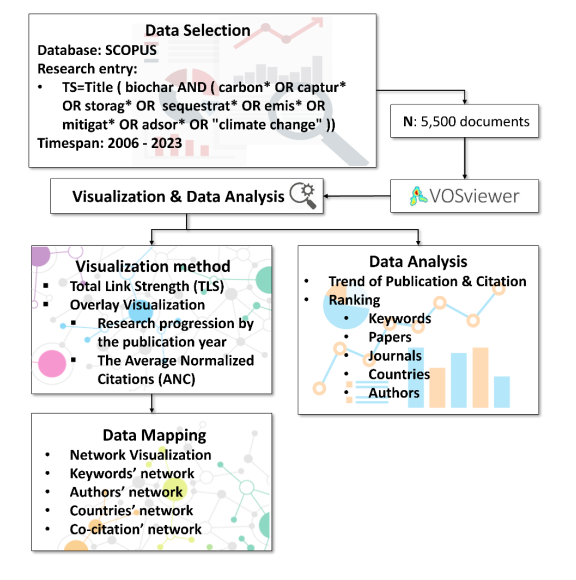









 DownLoad:
DownLoad:
